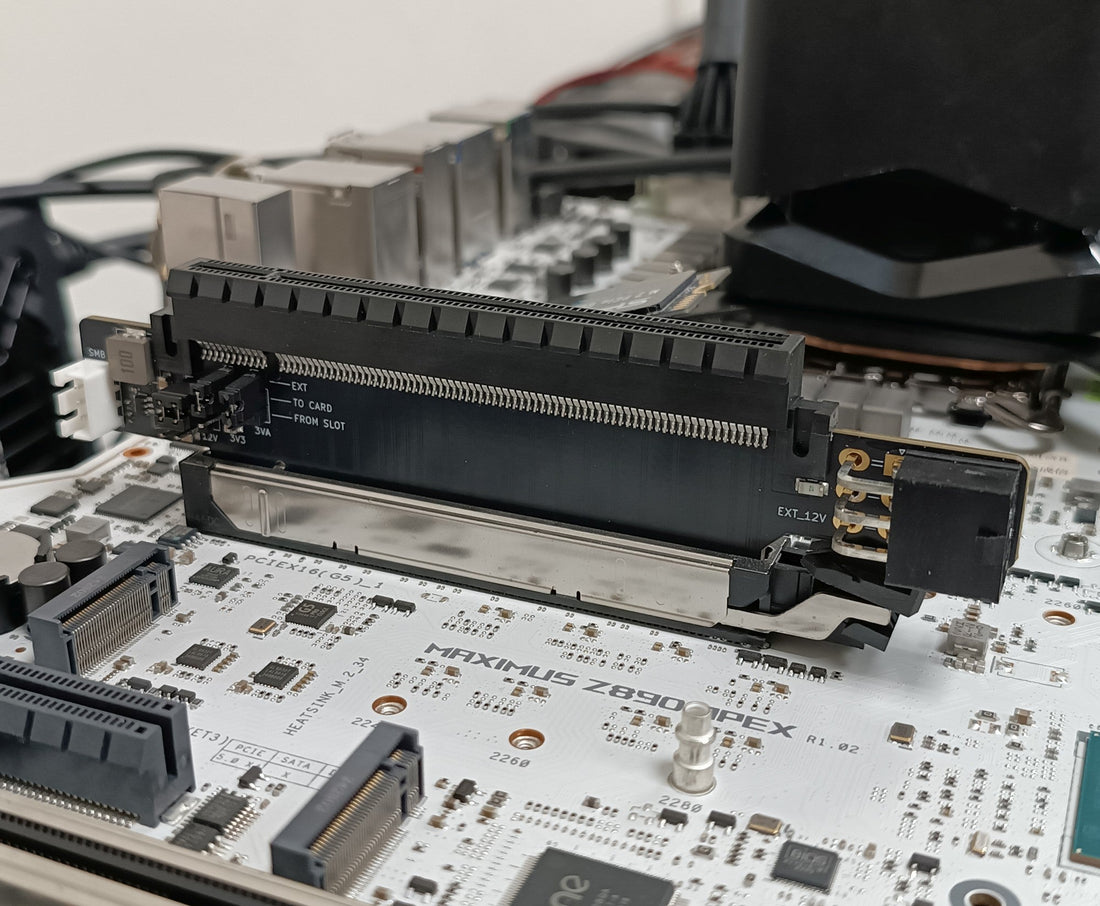We explore the methodology for measuring the power consumption of a PCIe x16 slot using the BENCHLAB and accompanying ElmorLabs PMD PCI-E Slot Power Measurement Adapter.
Why Care About PCIe Slot Power?
A PCI express slot can provide up to 75 watts (W) of power to a graphics card. That's a significant amount, especially for low-powered cards that might only draw 75W total. Even for high-powered cards with external PCIe 8-pin connectors, it can be an important part of the overall power consumption.
How to Measure PCIe Slot Power Consumption?
While the BENCHLAB offers the tools required to perform a comprehensive analysis of a graphics card's total power consumption via dedicated 3x PCIe and 2x 12VHPWR power supply cables, it cannot directly measure the power supplied through the PCIe slot.
While we need additional tools to measure the PCIe slot power consumption, we can still rely on BENCHLAB to capture the data.
The ElmorLabs PMD PCI-E Slot Power Measurement Adapter bypasses the motherboard's power delivery to the PCIe slot as the device uses a 4-pin CPU/EPS 12V input. We can supply this 12V input via the BENCHLAB which then allows us to capture the power consumption.
In January 2025, we also introduced the BENCHLAB PCI-E Slot Power Measurement Adapter (link). This adapter is similar in functionality but adds the option to isolate the 12V, 3.3V and 3.3VAUX rail. Additionally, its power source is a 6-pin PCIE 12V input.
PCIe Slot Power Measurement Procedure
The following steps outline the process of employing the BENCHLAB and ElmorLabs PMD PCI-E Slot Power Measurement Adapter or BENCHLAB PCI-E Slot Power Measurement Adapter.
- BENCHLAB Installation: follow the usual instructions for the BENCHLAB installation. Our typical system has the BENCHLAB sit between the motherboard and an Open Benchtable.
- Adapter Installation: insert the adapter into your motherboard PCIe slot.
- Power Connection: connect the power connector on the Slot Power Adapter to a dedicated cable from the BENCHLAB.
- Graphics Card Installation: now install the graphics card in the PCIe slot adapter.
- Software Configuration: The BENCHLAB software will automatically report the power consumption.

PCIe Slot Power Measurement Example
We set up a demo system to illustrate the process. The system consists of the following hardware:
- CPU: AMD Ryzen 5 8500GE processor
- Motherboard: ASUS ROG Crosshair X670E Hero motherboard
- Graphics Card: ASUS ROG Strix GeForce RTX 2080 Ti (2x PCIe power inputs)
- Telemetry: BENCHLAB-03
- Test Bench: Open Benchtable V2
We connect the PCI-E Slot Power Measurement Adapter to the appropriate power input for this measurement. Now, we use the following tools to capture the PCIe slot power consumption:
- The BENCHLAB telemetry software (link)
- HWiNFO system monitoring software (link)
- OCCT stress test software (link)
- ASUS GPU Tweak III tuning software (link)
In the standard configuration, we find the following reported power measurements:
|
Telemetry Source |
Measurement |
Power (W) |
|
BENCHLAB |
EPS1 Power (PCIe Slot) |
59.785 |
|
BENCHLAB |
PCIE1 Power |
123.804 |
|
BENCHLAB |
PCIE2 Power |
135.496 |
|
HWiNFO |
GPU Power |
258.369 |
|
HWiNFO |
NVVDD1 Input Power |
191.361 |
|
HWiNFO |
Misc1 Input Power |
4.129 |
|
HWiNFO |
Misc0 Input Power |
25.708 |
|
HWiNFO |
NVVDD Input Power |
232.663 |
The input power measurement by BENCHLAB is 319W (EPS1+PCIE1+PCIE2) whereas the reported HWiNFO GPU Power is 258W. If we exclude the PCIe Slot power measurement, then the reported input power by BENCHLAB is 259W.
If we increase the GPU power limit from the default 100% to 150% using the GPU Tweak III toolkit, we find the following reported power measurements.
|
Telemetry Source |
Measurement |
Power (W) |
|
BENCHLAB |
EPS1 Power (PCIe Slot) |
88.427 |
|
BENCHLAB |
PCIE1 Power |
187.098 |
|
BENCHLAB |
PCIE2 Power |
205.530 |
|
HWiNFO |
GPU Power |
386.055 |
|
HWiNFO |
NVVDD1 Input Power |
293.674 |
|
HWiNFO |
Misc1 Input Power |
4.138 |
|
HWiNFO |
Misc0 Input Power |
24.627 |
|
HWiNFO |
NVVDD Input Power |
361.430 |
The Input Power measurement by BENCHLAB is 481W (+151%) whereas the reported HWiNFO GPU Power is 386W (+149.6%).
Conclusion
In certain scenarios, measuring the PCIe slot power can be a valuable additional data point in your overall system power measurement. BENCHLAB offers great flexibility in various methods to capture that data.
You can purchase the both the BENCHLAB and the BENCHLAB PCI-E Slot Power Measurement Adapter in our web store.



